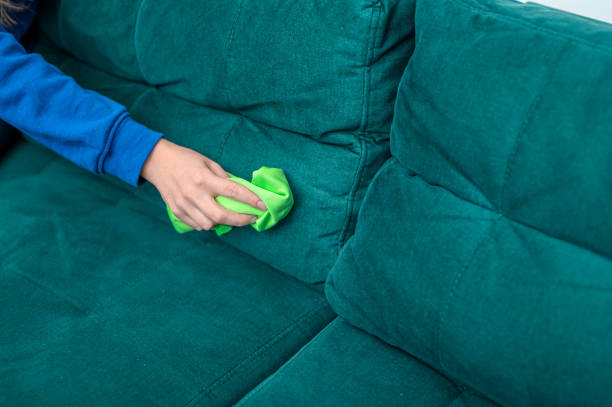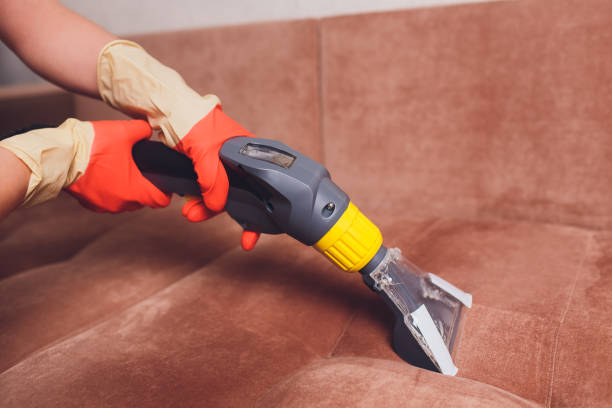Velvet upholstery is synonymous with luxury, elegance, and sophistication. Its smooth texture, vibrant colours, and plush appearance make it a desirable addition to any home or office space. However, maintaining the opulence of velvet furniture requires dedicated care and attention. The delicate fibres can become dull, stained, or damaged without proper cleaning and maintenance.
All of the information you require for cleaning velvet upholstery will be included in this thorough guide. From understanding the different velvet types to practical cleaning techniques, this guide will equip you with the knowledge to keep your velvet furniture pristine.
Types of Velvet Upholstery
Not all velvet is created equal. The type of velvet fabric your upholstery is made from will determine the best cleaning method. Here are some of the most common types of velvet used in furniture:
- Cotton Velvet: Soft, breathable, and natural, but it tends to crush easily, leaving pressure marks.
- Polyester Velvet: Durable, stain-resistant, and easier to maintain than other types.
- Viscose Velvet: Known for its luxurious sheen, it is prone to water damage and crushing.
- Wool Velvet: A natural option that is durable but requires extra care to prevent shrinkage.
- Linen Velvet: Textured and rustic in appearance, it offers a unique look but is susceptible to wrinkling.
- Silk Velvet: The most luxurious and delicate option. It is prone to watermarks and is best cleaned professionally.
Why Understanding Velvet Type Matters
Different velvet types respond differently to cleaning agents, water, and pressure. For example, polyester velvet is more forgiving and can sometimes be machine-washed, while silk and viscose velvet require professional care to avoid permanent damage. Check the care label on your furniture to determine the specific cleaning instructions for the fabric.
How to Clean Velvet Upholstery
Cleaning velvet requires more than a quick wipe-down. Here are essential steps to keep your furniture fresh, plush, and free from dirt or damage.
- Vacuum Regularly: Dust and debris can settle in the fibres, making your velvet look dull. Use a soft brush attachment to gently vacuum the surface weekly.
- Light Dusting: For lightly soiled velvet, a microfiber cloth or lint roller can pick up hair, lint, and light dust.
- Protect from Sunlight: Direct sunlight causes velvet to fade and discolour. Position your velvet furniture away from windows or use curtains to filter sunlight.
- Use an Upholstery Brush: Over time, sitting or lying on velvet upholstery compresses its fibres. Brushing the fabric restores its natural pile, keeping it soft and fluffy.
- Steam Treatment: Use a garment steamer on a low heat setting to reduce wrinkles, release compression, and refresh the fabric. Avoid applying direct steam to delicate fabrics like silk velvet.
- Protective Covering: If you’re not using your velvet furniture for an extended period, cover it with a dust-proof sheet to prevent dirt build-up.
- Avoid Water Exposure: Water can stain velvet, especially fabrics like viscose and silk. If your velvet upholstery comes into contact with water, blot it immediately with an absorbent cloth.
How to Remove Stains from Velvet Upholstery
Stains can be a nightmare for velvet furniture. If you act quickly, you can prevent permanent damage. Here’s a step-by-step guide to dealing with spills and stains on velvet upholstery:
- Remove Solids First: Use a blunt knife or spatula to gently lift off solid particles without pushing them deeper into the fabric.
- Vacuum Loose Particles: Use a soft brush attachment on a vacuum cleaner to remove any remaining dirt, pet hair, or crumbs.
- Blot Fresh Stains: Use an absorbent cloth or paper towel to blot the area if the stain is from a spill. Do not rub; this may push the stain deeper into the fibres.
- Prepare a Cleaning Solution: Choose one of the following DIY cleaning solutions:
- A drop of dishwashing liquid mixed with one cup of cool water
- A mixture of baking soda and lemon juice
- Equal parts of water and white vinegar
- Spot Clean the Stain: Dampen a clean cloth with the cleaning solution and dab (do not rub) the stain. Use minimal moisture to avoid water stains.
- Blot Dry: Blot the area with a dry cloth to soak up any excess moisture once the stain is removed.
- Restore the Pile: Gently brush the velvet toward the pile to maintain its soft, fluffy look.
When to Call a Professional Cleaner
While home cleaning can handle minor issues, there are times when professional help is necessary:
- Deep Cleaning: If your velvet upholstery hasn’t been cleaned in over a year, a professional cleaner can perform a deep clean to refresh the entire piece.
- Persistent Stains: Some stains, such as ink or wine, may require expert knowledge and industrial cleaning agents to remove them without damaging the fabric.
- Silk Velvet: Due to its delicate nature, silk velvet is best left to professional cleaners who specialize in handling fine fabrics.
- Water Damage: If watermarks remain after attempting a DIY clean, professional cleaners can often reverse the damage.
Hiring a professional upholstery cleaner may seem costly, but avoiding the risk of ruining expensive velvet furniture is often worth it.
Preventive Measures to Keep Velvet Looking New
Prevention is better than cure, and with a few proactive measures, you can keep your velvet upholstery looking new for longer.
- Apply Fabric Protector: Use a fabric protector spray designed for velvet to create a barrier against stains, spills, and dirt.
- Rotate Cushions: If your furniture has removable cushions, rotate them regularly to ensure even wear and tear.
- Limit Food and Drink Near Upholstery: Avoid eating and drinking near velvet furniture to reduce the risk of stains.
- Use Throws and Covers: Placing a decorative throw over the sofa’s seating area provides an extra layer of protection while enhancing the room’s aesthetics.
- Set House Rules: Encourage children and pets to treat velvet furniture carefully to reduce the risk of spills and scratches.
DIY vs. Professional Cleaning: Which Is Best?
When deciding whether to clean your velvet upholstery yourself or hire a professional, consider the following factors:
- Type of Velvet: Polyester and cotton velvets are more forgiving and can be cleaned at home, while silk and viscose velvets require professional care.
- Severity of the Stain: Fresh, minor stains can be treated at home, but deep-set stains may need professional intervention.
- Time and Effort: DIY cleaning is cost-effective but requires patience and precision. Professional cleaners save time and ensure the job is done right.

Conclusion
Velvet upholstery is a timeless addition to any home, offering luxury, beauty, and comfort. Proper care and regular cleaning are essential to maintaining its elegance. By identifying the type of velvet you have and following the best cleaning practices, you can preserve the charm of your furniture for years to come.
Whether brushing away daily dust or tackling a stubborn stain, this guide provides the techniques to care for your velvet upholstery. However, when in doubt, professional cleaning is the safest option. With this knowledge, you can now enjoy the beauty of velvet furniture without the stress of potential stains or damage.

